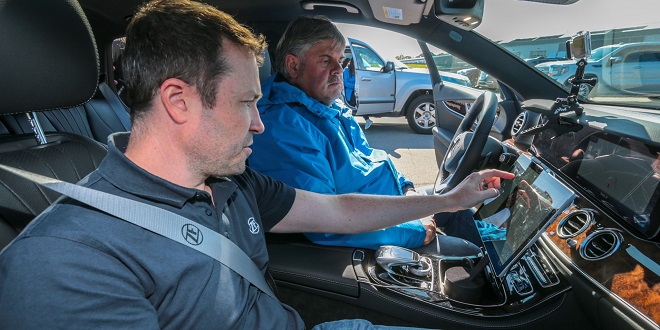Blind-spot information systems (BLIS)

The area where drivers can’t see vehicles in adjoining lanes behind or to the side when using their side and rear-view mirrors is called the blind spot. Collisions and near-misses when changing lanes because the blind spot rendered a vehicle invisible is a daily occurrence on most highways and busy streets. As a result, Volvo has led the way in developing a blind-spot information system (BLIS) that employs a little camera mounted on each side mirror to alert drivers who are planning to change lanes to vehicles in those lanes that they may otherwise not be able to see. It also tells drivers when there is sufficient space to change lanes safely.
When a vehicle appears in a blind spot, the camera on that side activates a light on the door panel near that mirror. When there’s enough room to change lanes safely, the light goes off. Drivers testing this system report that the light isn’t distracting when they aren’t looking to change lanes and that checking to see whether the light is on before changing lanes quickly becomes as natural as checking the mirrors.
Drivers are warned about extensive blind spots on large trucks that make smaller vehicles all but invisible to truck drivers. Hopefully, BLIS will help to rectify that situation, especially if the federal government sees fit to mandate it for use on commercial vehicles. Until then, watch for BLIS systems to appear on a growing number of passenger vehicles. I hope every driver can be in a state of BLIS before long.
Brake-Shift Interlocks
A brake-shift interlock is a device that prevents the gearshift from being accidentally shifted out of the Park position, which could allow the vehicle to accidentally roll into danger. The device makes it impossible to move the gearshift without simultaneously stepping on the brake pedal. Although many vehicles already come with this as standard equipment, in 2006, in response to a growing number of accidents involving children injured while playing with gearshifts, NHTSA and 19 automakers agreed to have brakeshift interlocks on all new vehicles by 2010.
Traction Control Systems (TCS)
Traction control systems (TCS) have been around, in one form or another, for years (see Figure 19-7). The system senses when one or more wheels is spinning faster than the others and attempts to prevent the vehicle from going out of control. The problem can be due to a slippery surface but also can occur when a vehicle with front-wheel drive is driven so hard that the drive wheels don’t steer properly and lose traction.
Electronic traction control systems use the anti-lock braking system (ABS) to sense and compare the speed of each wheel and automatically pump the brake on a wheel that’s spinning faster than the others.
Electronic Stability Control (ESC)
Making emergency maneuvers to avoid obstacles, taking turns at high speeds, and cornering too sharply or too fast are some of the situations that can cause your vehicle to veer from the path you expect to follow when you turn the steering wheel. As a result, your vehicle either overseers (turns more radically because it’s sliding or spinning) or understeers (turns less than you planned because it loses traction). Electronic stability control (ESC) keeps your vehicle on the straight and narrow to prevent it from skidding sideways, spinning out, or rolling over.
As you can see in Figure 19-8, ESC uses the wheel-speed sensors that enable ABS and TCS. It also has a sensor that monitors the steering angle (the position of the steering wheel) and compares it with the data from a rotation sensor that monitors the yaw angle (how much the vehicle is rocking from side to side) to see where the vehicle is actually going.
Last word
Other sensors can measure additional types of movement. With all this input, the vehicle’s ECU can monitor how well your vehicle is responding to the position of the steering wheel and, by activating the brakes on the proper wheels and modulating power, correct the course of your vehicle so that you can go on your way safely.





